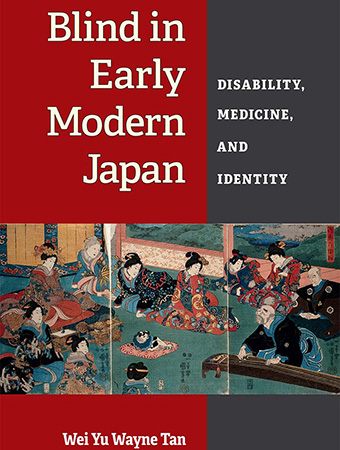
Through his book “Blind in Early Modern Japan: Disability, Medicine, and Identity,” Dr. Wei Yu Wayne Tan of the Hope College history faculty seeks to provide a new way of understanding not only disability but also history and culture.
“It’s a less traditional way of telling the history of a place,” said Tan, who is an associate professor of history at Hope. “It allows us to look not only into the institutional background of disability, but also to look at sources that tell us about everyday life and see how Japanese society functioned, and to include marginalized voices to tell a different side of history and to reexamine our assumptions about disability,”
“Blind in Early Modern Japan” was published by the University of Michigan Press in 2022. Covering the Edo Period (1600-1868) when Japan was ruled by the Tokugawa shogunate, Tan examines how blind people in Japan were able to thrive, gaining power and respect in society, through prominence in a range of professions. The book focuses especially on a guild of blind traveling musicians that also led a network of other guilds, in fields such as massage and acupuncture, that consisted of blind people. United through their strong guild structure, they were even able to monopolize some trades.
“In the United States and Europe, we don’t see this organization of blind people and blind professionals,” Tan said. “While we tend to think of disability in negative terms, the historical narrative that I outline for Japan is more complex. There were blind people who worked within the system and gained some advantages for themselves, but also many others who were left out and even exploited.”
It’s an approach that has earned praise from numerous reviewers. Most recently, “Choice 360” of the Association of College and Research Libraries featured the book in conjunction with its commemoration of July’s Disability Pride Month, summarizing it as “highly recommended” and calling it an “important contribution to disability studies.” In its review, the journal Social History of Medicine said, “More than simply presenting Tokugawa Japan as a case study in the larger corpus of the history of disability, it encourages scholars to reconsider approaches to writing about blindness and visual impairment.”
“Blind in Early Modern Japan” chronicles the beginning of a story that Tan has been exploring for more than a decade. He initially became interested in the topic during his first visit to Japan in 2009, when he noticed extensive infrastructure for people with visual impairments that included audio cues and tactile indicators at intersections for pedestrians.
Since the 2022 book’s publication, he has been conducting research for a new volume that will carry the story forward in time, beginning in 1868 with the Meiji Restoration that reestablished imperial rule and continuing through the end of World War II in 1945. “I’m interested in how disability from the early modern period became disability in modern Japan, with a focus on science and medicine as Japan started to form itself into a modern nation-state increasingly influenced by Europe and the United States,” he said.
Tan has been a member of the Hope faculty since 2016, and was previously an Andrew W. Mellon Postdoctoral Fellow in the Humanities at Dartmouth College. He has presented his past and current research at professional meetings including the National Endowment for the Humanities Summer Institute on the Global Histories of Disability, the Association for Asian Studies, the American Historical Association and others. His publications cover historical topics about Japan and East Asia from the 17th century to the present, including disability in modern East Asia, and acupuncture and anatomy in East Asian medical thought. He teaches courses in world history, Japanese history, East Asian cultural history, Russian history, disability history/studies, pandemics and social history, and the history of science and medicine.